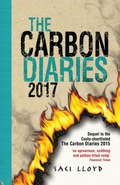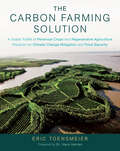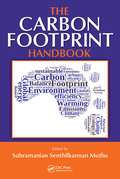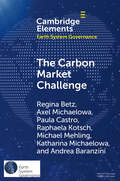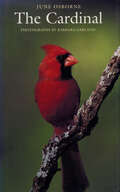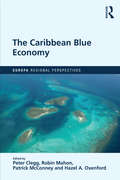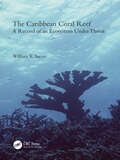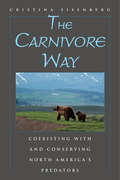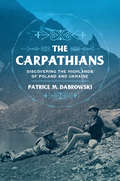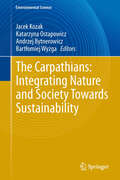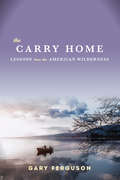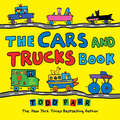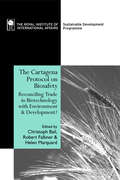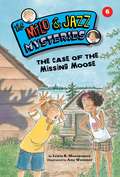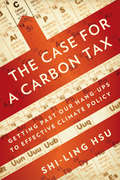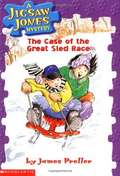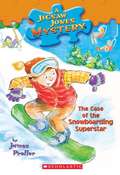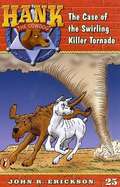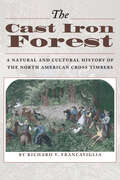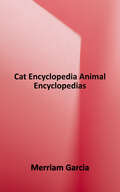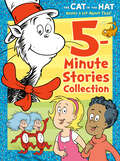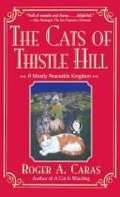- Table View
- List View
The Carbon Diaries 2017: Book 2
by Saci LloydIt's over a year since her last diary and Laura Brown is now in her first year of university in London, a city still struggling to pull itself together in the new rationing era. Laura's right in the heart of it; her band, the dirty angels, are gigging all over town until a police crackdown on rioting students forces them out of the city. After a brief exile on her parents' farm, the angels set off in a battered VW bus on a tour of Europe with the fabulous Tiny Chainsaws in the Distance.The tour soon unravels, however, in an increasingly dramatic sequence of events that include drought in Europe and Africa, a tidal-wave of desperate immigrants, a water war in the Middle East and a city-wide face off with the army in London. Not to mention infidelity, betrayal, friendship, love and massive courage.How long can Laura distance herself from the struggle? And more importantly, how can she keep her style and hope alive in a world on the edge of madness?
The Carbon Farming Solution: A Global Toolkit of Perennial Crops and Regenerative Agriculture Practices for Climate Change Mitigation and Food Security
by Eric ToensmeierWith carbon farming, agriculture ceases to be part of the climate problem and becomes a critical part of the solution&“This book is the toolkit for making the soil itself a sponge for carbon. It&’s a powerful vision.&”—Bill McKibben&“The Carbon Farming Solution is a book we will look back upon decades from now and wonder why something so critically relevant could have been so overlooked until that time. . . . [It] describes the foundation of the future of civilization.&”—Paul HawkenIn this groundbreaking book, Eric Toensmeier argues that agriculture—specifically, the subset of practices known as &“carbon farming&”—can, and should be, a linchpin of a global climate solutions platform. Carbon farming is a suite of agricultural practices and crops that sequester carbon in the soil and in above-ground biomass. Combined with a massive reduction in fossil fuel emissions—and in concert with adaptation strategies to our changing environment— carbon farming has the potential to bring us back from the brink of disaster and return our atmosphere to the &“magic number&” of 350 parts per million of carbon dioxide. Toensmeier&’s book is the first to bring together these powerful strategies in one place.Includes in-depth analysis of the available research.Carbon farming can take many forms. The simplest practices involve modifications to annual crop production. Although many of these modifications have relatively low sequestration potential, they are widely applicable and easily adopted, and thus have excellent potential to mitigate climate change if practiced on a global scale. Likewise, grazing systems such as silvopasture are easily replicable, don&’t require significant changes to human diet, and—given the amount of agricultural land worldwide that is devoted to pasture—can be important strategies in the carbon farming arsenal. But by far, agroforestry practices and perennial crops present the best opportunities for sequestration. While many of these systems are challenging to establish and manage, and would require us to change our diets to new and largely unfamiliar perennial crops, they also offer huge potential that has been almost entirely ignored by climate crusaders. Many of these carbon farming practices are already implemented globally on a scale of millions of hectares. These are not minor or marginal efforts, but win-win solutions that provide food, fodder, and feedstocks while fostering community self-reliance, creating jobs, protecting biodiversity, and repairing degraded land—all while sequestering carbon, reducing emissions, and ultimately contributing to a climate that will remain amenable to human civilization. Just as importantly to a livable future, these crops and practices can contribute to broader social goals such as women&’s empowerment, food sovereignty, and climate justice. The Carbon Farming Solution is—at its root—a toolkit and the most complete collection of climate-friendly crops and practices currently available.With this toolkit, farmers, communities, and governments large and small, can successfully launch carbon farming projects with the most appropriate crops and practices to their climate, locale, and socioeconomic needs. Toensmeier&’s ultimate goal is to place carbon farming firmly in the center of the climate solutions platform, alongside clean solar and wind energy. With The Carbon Farming Solution, Toensmeier wants to change the discussion, impact policy decisions, and steer mitigation funds to the research, projects, and people around the world who envision a future where agriculture becomes the protagonist in this fraught, urgent, and unprecedented drama of our time. Citizens, farmers, and funders will be inspired to use the tools presented in this important book to transform degraded lands around the world into
The Carbon Footprint Handbook
by Subramanian Senthilkannan MuthuThorough and detailed, The Carbon Footprint Handbook encompasses all areas of carbon footprint, including the scientific elements, methodological and technological aspects, standards, industrial case studies, and communication of carbon footprint results. Written and edited by an international group of experts, the far-ranging topics on carbon foot
The Carbon Market Challenge: Preventing Abuse Through Effective Governance (Elements in Earth System Governance)
by Michael Mehling Paula Castro Axel Michaelowa Regina Betz Andrea Baranzini Raphaela Kotsch Katharina MichaelowaCarbon markets – both emission trading systems and baseline and credit systems – are an increasingly common policy instrument being introduced to address climate change mitigation. However, their design is crucial to ensure that they deliver cost-effective emission reductions while maintaining environmental integrity. This Element puts together a comprehensive, principle-based overview of the risks and abuses to environmental integrity and cost effectiveness that have emerged for carbon markets at all jurisdictional levels around the world, provides concrete examples, and offers effective policy and governance solutions to overcome such risks. This title is also available as Open Access on Cambridge Core.
The Cardinal (Corrie Herring Hooks Series)
by June OsborneIn this inviting guide, June Osborne and Barbara Garland follow a year in the life of the Northern Cardinal with a fact-filled text and glowing color photographs. They describe how cardinals stake out territory and choose mates, find a nesting site and incubate their eggs, feed the young and prepare them for full-fledged independence. The Cardinal also explores the special relationship that humans have with their favorite redbirds. Osborne traces the symbolic use of cardinals as state birds (Illinois, Indiana, Kentucky, North Carolina, Ohio, Virginia, and West Virginia) and athletic mascots and shows how they appear on everything from postage stamps to Christmas cards, as well as in fine art, literature, and Native American folklore.
The Carey Act and Conservation in Colorado
by Gerald C. MortonThe Carey Act and Conservation in Colorado is an environmental history of the endless missteps and unforeseen consequences that characterized Colorado’s participation in the Carey Act—an 1894 federal law that granted one million acres of desert-classified public land to each western state for private irrigation development and settlement. In this inclusive narrative, author Gerald Morton reveals how this obscure law affected thirty-four of Colorado’s most arid stretches of landscape. Morton contextualizes the Carey Act’s significance in Colorado through a study of the Two Buttes and Muddy Creek projects in the state’s southeastern corner—tragic examples of the disconnect among developers seeking windfall profits in the face of financial rollercoasters, the challenge of reclaiming remote sagebrush country, and settlers seeking viable livelihoods that eventually led conservationists to reimagine the failures as public wildlife refuges. A collision of values between developers and settlers lay at the center of those wildlife habitat conservation efforts, forcing people to rethink their relationship with the land and ephemeral streams—an awareness that correlated with the advent of modern ecology. The Carey Act and Conservation in Colorado is the untold story of the manipulation of nature and the reconceived use of land for public wildlife areas on the southern plains of the American West. Offering original research on arid lands policy, federal and state agency oversight, irrigation bond financing, heartbroken settlers’ grievances, individual developers’ motives, and the rise of wildlife conservation, this compelling tale of misfortune will appeal to scholars and general readers interested in conservationist and environmental history in the American West.
The Caribbean Blue Economy (Europa Regional Perspectives)
by Peter Clegg, Robin Mahon, Patrick McConney and Hazel A. OxenfordThe Blue Economy is emerging on the global scene as a powerful and persuasive new concept for sustainable development based on economic activities associated with the ocean. Several regions globally have adopted this concept at national and regional levels, including the Caribbean. Given the complex, multisectoral and multilevel nature of the Blue Economy, it is clear that different approaches will be needed for different regions. Hence, this volume explores the opportunities, threats and risks involved in operationalising the Blue Economy in the Wider Caribbean Region, defined as northern Brazil to the USA and all mainland and island countries and territories in-between. The first part of the book looks at where the region stands in the global picture regarding adoption of the Blue Economy and what is planned. The second set of chapters examines key crosscutting issues such as ecosystem services, climate change and governance at national and regional levels that could make or break the Blue Economy initiative. The book then goes on to explore the main sectoral activities that will constitute the Blue Economies in the region: fisheries, tourism, shipping and transport, renewable energy, oil and gas, seabed mining and waste management are all considered. The book ends with a synthesis of the political and technical requirements to overcome threats and take advantage of opportunities in the Blue Economy.
The Caribbean Coral Reef: A Record of an Ecosystem Under Threat
by William K. SaccoThis book is a visual tour of Caribbean coral reefs between 1968 and 1978. They are the world’s second largest coral reef community and the most threatened. The Caribbean Coral Reef: A Record of an Ecosystem Under Threat offers a priceless historical record made by a photographer who set out to document the major reef species when those reefs were at their prime. Today, coral reefs are under threat as never before and, sadly, most of what is shown in the book's photographs is now gone forever. It is only by comparing the images in this book with what we see now that we are able to fully recognize what we have lost. With its stunning photography and precise, accurate scientific information, this book offers students of coral reefs a wealth of information about this rich, fragile ecosystem. It is also written accessibly for non-academic visitors to the Caribbean reef or anyone interested in the earth’s creatures. Many of the invertebrates will be unfamiliar to most people, and the author reveals fascinating insights into these otherworldly creatures and their lifestyles. Enjoy this field guide to the reefs that were, and savor the beauty of this vanishing environment and its organisms.
The Carnivore Way: Coexisting with and Conserving North America's Predators
by Cristina EisenbergWhat would it be like to live in a world with no predators roaming our landscapes? Would their elimination, which humans have sought with ever greater urgency in recent times, bring about a pastoral, peaceful human civilization? Or in fact is their existence critical to our own, and do we need to be doing more to assure their health and the health of the landscapes they need to thrive? In The Carnivore Way, Cristina Eisenberg argues compellingly for the necessity of top predators in large, undisturbed landscapes, and how a continental-long corridor--carnivore way--provides the room they need to roam and connected landscapes that allow them to disperse. Eisenberg follows the footsteps of six large carnivores--wolves, grizzly bears, lynx, jaguars, wolverines, and cougars--on a 7,500-mile wildlife corridor from Alaska to Mexico along the Rocky Mountains. Backed by robust science, she shows how their well-being is a critical factor in sustaining healthy landscapes and how it is possible for humans and large carnivores to coexist peacefully and even to thrive. University students in natural resource science programs, resource managers, conservation organizations, and anyone curious about carnivore ecology and management in a changing world will find a thoughtful guide to large carnivore conservation that dispels long-held myths about their ecology and contributions to healthy, resilient landscapes.
The Carpathians: Discovering the Highlands of Poland and Ukraine (NIU Series in Slavic, East European, and Eurasian Studies)
by Patrice M. DabrowskiIn The Carpathians, Patrice M. Dabrowski narrates how three highland ranges of the mountain system found in present-day Poland, Slovakia, and Ukraine were discovered for a broader regional public. This is a story of how the Tatras, Eastern Carpathians, and Bieszczady Mountains went from being terra incognita to becoming the popular tourist destinations they are today. It is a story of the encounter of Polish and Ukrainian lowlanders with the wild, sublime highlands and with the indigenous highlanders—Górale, Hutsuls, Boikos, and Lemkos—and how these peoples were incorporated into a national narrative as the territories were transformed into a native/national landscape.The set of microhistories in this book occur from about 1860 to 1980, a time in which nations and states concerned themselves with the "frontier at the edge." Discoverers not only became enthralled with what were perceived as their own highlands but also availed themselves of the mountains as places to work out answers to the burning questions of the day. Each discovery led to a surge in mountain tourism and interest in the mountains and their indigenous highlanders.Although these mountains, essentially a continuation of the Alps, are Central and Eastern Europe's most prominent physical feature, politically they are peripheral. The Carpathians is the first book to deal with the northern slopes in such a way, showing how these discoveries had a direct impact on the various nation-building, state-building, and modernization projects. Dabrowski's history incorporates a unique blend of environmental history, borderlands studies, and the history of tourism and leisure.
The Carpathians: Integrating Nature and Society Towards Sustainability
by Bartłomiej Wyżga Andrzej Bytnerowicz Jacek Kozak Katarzyna OstapowiczThe book includes a broad spectrum of perspectives from different scientific disciplines (both the natural and social sciences) as well as practical knowledge. It gives a new insight into the Carpathian mountain region
The Carry Home: Lessons from the American Wilderness
by Gary FergusonThe nature writing of Gary Ferguson arises out of intimate experience. He trekked 500 miles through Yellowstone to write Walking Down the Wild and spent a season in the field at a wilderness therapy program for Shouting at the Sky. He journeyed 250 miles on foot for Hawks Rest and followed through the seasons the first fourteen wolves released into Yellowstone National Park for The Yellowstone Wolves. But nothing could prepare him for the experience he details in his new book.The Carry Home is both a moving celebration of the outdoor life shared between Ferguson and his wife Jane, who died tragically in a canoeing accident in northern Ontario in 2005, and a chronicle of the mending, uplifting power of nature. Confronting his unthinkable loss, Ferguson set out to fulfill Jane's final wish: the scattering of her ashes in five remote, wild locations they loved and shared. The act of the carry home allows Ferguson the opportunity to ruminate on their life together as well as explore deeply the impactful presence of nature in all of our lives.Theirs was a love borne of wild places, and The Carry Home offers a powerful glimpse into how the natural world can be a critical prompt for moving through cycles of immeasurable grief, how bereavement can turn to wonder, and how one man rediscovered himself in the process of saying goodbye.
The Cars and Trucks Book
by Todd ParrFrom bestselling and beloved author Todd Parr, a new book about all of the different ways that cars and trucks help people and have fun. Some trucks help on the farm. Some trucks help in the city. Some cars like to drive in the snow. And some cars like to drive to the beach. All cars and trucks LOVE to be on the ROAD!Todd Parr brings his trademark bright colors and bold lines to his new book about cars, trucks, and the occasional bus. In a fun collection of silly images, Todd explores all of the ways vehicles have an impact on our daily lives, while weaving in messages about positivity, the environment, and safety. Readers will laugh along with the whole four-wheeled gang!
The Cartagena Protocol on Biosafety: Reconciling Trade in Biotechnology with Environment and Development
by Robert Falkner Christoph Bail Helen MarquardModern biotechnology - the controversial manipulation of genes in living organisms - has far-reaching implications for agriculture, human health, trade and the environment. Against the odds, an international treaty governing biosafety and trade in biotechnology was adopted in 2000. The Cartagena Protocol on Biosafety of the Convention on Biological Diversity deals with one of the most important and challenging issues thrown up by developments in biotechnology. This volume is a comprehensive review of the protocol and the process that led to its adoption. It includes contributions from many of the key players involved and analyses the commercial and political interests at stake, the operations and implications of the protocol, and prospects for the future.
The Case for a Carbon Tax: Getting Past Our Hang-ups to Effective Climate Policy
by Shi-Ling HsuThere's a simple, straightforward way to cut carbon emissions and prevent the most disastrous effects of climate change-and we're rejecting it because of irrational political fears. That's the central argument of The Case for a Carbon Tax, a clear-eyed, sophisticated analysis of climate change policy. Shi-Ling Hsu examines the four major approaches to curbing CO2: cap-and-trade; command and control regulation; government subsidies of alternative energy; and carbon taxes. Weighing the economic, social, administrative, and political merits of each, he demonstrates why a tax is currently the most effective policy. Hsu does not claim that a tax is the perfect or only solution-but that unlike the alternatives, it can be implemented immediately and paired effectively with other approaches. In fact, the only real barrier is psychological. While politicians can present subsidies and cap-and-trade as "win-win" solutions, the costs of a tax are immediately apparent. Hsu deftly explores the social and political factors that prevent us from embracing this commonsense approach. And he shows why we must get past our hang-ups if we are to avert a global crisis.
The Case for the Green New Deal
by Ann PettiforWhat is the Green New Deal and how can we afford it?To protect the future of life on earth, we need to do more than just reimagine the economy—we have to change everything. One of the seminal thinkers of the program that helped ignite the US Green New Deal campaign, Ann Pettifor explains how we can afford what we can do, and what we need to do, before it is too late. The Case for the Green New Deal argues that economic change is wholly possible, based on the understanding that finance, the economy and the ecosystem are all tightly bound together. The GND demands total decarbonization and a commitment to an economy based on fairness and social justice. It proposes a radical new understanding of the international monetary system. Pettifor offers a roadmap for financial reform both nationally and globally, taking the economy back from the 1%. This is a radical, urgent manifesto that we must act on now.
The Case of the Great Sled Race (Jigsaw Jones Mystery #8)
by James PrellerAfter a huge snowstorm, the neighborhood kids go sledding at Long Hill. Everyone's having a great time--until one of the sleds disappears. Super-sleuth Jigsaw Jones and his partner, Mila, must solve this chilly case. Humorous line drawings throughout.
The Case of the Snowboarding Superstar (Jigsaw Jones Mystery #29)
by James PrellerJigsaw and his family bond during a wintry weekend getaway complete with snowboarding and sledding -- but a real detective, like Jigsaw Jones, is never truly off-duty. When trouble hits the slopes, Jigsaw gears up to solve a puzzling mystery, and all without the aid of his partner, Mila. Can Jigsaw solve the case before his family packs their bags for home?
The Case of the Swirling Killer Tornado (Hank the Cowdog Series, #25)
by John R. EricksonAttacked by an invisible enemy, Hank rushes to the house to make sure his family is safe, but the house is in the path of a killer tornado and Hank gets trapped inside the house.
The Cast Iron Forest: A Natural and Cultural History of the North American Cross Timbers (Corrie Herring Hooks Series #43)
by Richard V. Francaviglia&“A thoughtful, thorough, and updated account of this bio-region&” from the author of From Sail to Steam: Four Centuries of Texas Maritime History, 1500-1900 (Great Plains Research). Winner, Friends of the Dallas Public Library Award, Texas Institute of Letters, 2001 A complex mosaic of post oak and blackjack oak forests interspersed with prairies, the Cross Timbers cover large portions of southeastern Kansas, eastern Oklahoma, and north central Texas. Home to indigenous peoples over several thousand years, the Cross Timbers were considered a barrier to westward expansion in the nineteenth century, until roads and railroads opened up the region to farmers, ranchers, coal miners, and modern city developers, all of whom changed its character in far-reaching ways. This landmark book describes the natural environment of the Cross Timbers and interprets the role that people have played in transforming the region. Richard Francaviglia opens with a natural history that discusses the region&’s geography, geology, vegetation, and climate. He then traces the interaction of people and the landscape, from the earliest indigenous inhabitants and European explorers to the developers and residents of today&’s ever-expanding cities and suburbs. Many historical and contemporary maps and photographs illustrate the text. &“This is the most important, original, and comprehensive regional study yet to appear of the amazing Cross Timbers region in North America . . . It will likely be the standard benchmark survey of the region for quite some time.&” —John Miller Morris, Assistant Professor of Geography, University of Texas at San Antonio
The Cat Encyclopedia (Encyclopedias for Kids)
by Merriam GarciaThis encyclopedia highlights more than 50 different cats. Alongside colorful photographs of both adult cats and kittens, readers learn about the history, appearance, and behavior of various breeds. Features include information about cat care, a glossary, additional resources, and an index. Aligned to Common Core Standards and correlated to state standards. Abdo Reference is an imprint of Abdo Publishing, a division of ABDO.
The Cat in the Hat Knows a Lot About That 5-Minute Stories Collection (Dr. Seuss /The Cat in the Hat Knows a Lot About That)
by Random HouseA fun-filled collection of stories starring Dr. Seuss's Cat in the Hat that can each be read aloud in five minutes!Nick and Sally have questions about everything from trees to outer space. Luckily, the Cat in the Hat has the answers. Based on the TV series The Cat in the Hat Knows a Lot About That, this hardcover collection of rhyming tales is sure to fascinate and entertain boys and girls ages 3 to 7. Each story can be read in five minutes or less, so they're perfect for bedtime--or anytime!
The Catch of a Lifetime: Moments of Flyfishing Glory
by Peter KaminskyA gorgeously illustrated collection of first-person stories on the sublime joy of flyfishing Every fly fisher has one: that moment—that ineffable, transcendent moment—they can point to and say, That&’s it. That was when time seemed to stop and I felt fully alive. That&’s why I fish. Collected and framed by the award-winning writer Peter Kaminsky, The Catch of a Lifetime presents the moving first-person stories of more than seventy anglers recounting their catch of a lifetime. With its tales of brown trout in Montana and bluefish at Montauk Point, smallmouth in Minnesota&’s Boundary Waters and unforgettable adventures with giant taimen on the steppes of central Asia, bonefish in New Caledonia, white marlin in the Baja, and golden dorado in the tribal lands along the Amazon&’s headwaters, this gorgeously illustrated anthology is a transporting testament to the call that all anglers heed—to get out there and be one with the water. It distills perfectly the magic of the sport; you can&’t read it and not want to go fishing. The contributor list is a diverse who&’s who of writers, artists, sportspeople, and others who&’ve made flyfishing a singular passion, including Carl Hiaasen, Joan Wulff, Tom Colicchio, Charles Gaines, Rachel Maddow, Mark Kurlansky, Brittany Howard, John McPhee, Verlyn Klinkenborg, and Jared Zissu. Their encounters, their memories, the words they use to describe, say, a forty-pound salmon leaping into the air or the sight of a great blue heron soaring down the creek to steal a catch make this the book of a lifetime for any fly fisher.
The Cats of Thistle Hill: A Most Peaceable Kingdom
by Roger A. CarasFrom the book jacket: The cats of Thistle Hill are the ten-plus cats who live with Roger Caras and his family on their farm in Maryland-along with dogs, horses, birds, cows, and even a llama. Thistle Hill itself is as much a character in The Cats of Thistle Hill as are the cats, with its secret tunnel, barn, pastures and streams, and the staff of workers who care for the thirty-odd animals and the farmhouse and surroundings full-time. In this charming book, cat lovers will meet some of the most memorable felines ever found between covers-Teddy, who holds court in a private room in Caras's house; Xnard, who survived an LSD experiment before being rescued by the the author's son; and Omari, a tomcat who brings back some pretty strange objects from his wanderings around Caras's farm. Each cat has a different history and each illustrates some truths about what cats need and expect from us and what we need and expect from cats. Throughout the book are photographs of the animals of Thistle Hill and of the daily routine of life on the farm. The Cats of Thistle Hill also provides fascinating information for cat owners or those who are thinking about ownership, including valuable sections on feline breeds, behavior, and diseases, with plenty of practical information on topics such as choosing a cat, neutering and spaying, and immunizations. Animal lovers of all kinds will find much to enjoy in The Cats of Thistle Hill With wit and humor, and in charming and telling detail, Roger Caras offers a memorable account of life in the "mostly peaceable kingdom" of Thistle Hill. ROGER A. CARAS is the eighteenth president of the American Society for the Prevention of Cruelty to Animals, the ASPCA, the oldest humane organization in the Western Hemisphere. Prior to taking on the leadership of the "A," he was with ABC Network for seventeen years, the only correspondent with any network to have the title Special Correspondent for Animals and the Environment. He is the author of more than sixty books. A selection of the Book-of-the-Month Club
